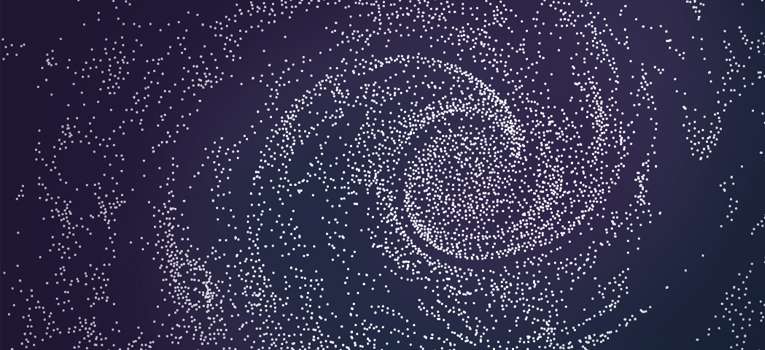Physicists reveal the role of diffusion in the early universe

Scientists from the Space Research Institute of the Russian Academy of Sciences (IKI RAS), the Moscow Institute of Physics and Technology (MIPT), and the Max Planck Institute for Astrophysics (MPA) have shown that diffusion of gas particles during the formation of the first structures in the early universe could have impacted the relative abundance of helium and hydrogen in the first galaxies.
According to their calculations, the diffusion-induced element abundance changes are comparable to the precision of current cosmological measurements. This means that the observed hydrogen and helium abundance may differ from theoretical predictions. The research was published in the Monthly Notices of the Royal Astronomical Society.
The scientists want to know what role diffusion played in the formation of the first stars and galaxies. The reason for their heightened interest is that the accuracy of direct measurements of primordial elements abundance has been steadily improving.
To describe the state of the universe during all stages of its development, physicists assign values to the so-called cosmological parameters. Among them are the Hubble parameter, which determines the rate of expansion of the universe, and the parameters that specify the matter and dark energy content in the universe. The values of these parameters vary with time. Knowing their right values for the different stages of the evolution of the universe would allow physicists to arrive at a correct cosmological model and peer billions of years into the past or into the future. Techniques have been developed to compute the value of the cosmological parameters with a high degree of precision. One of these techniques is the direct observation of primordial elements abundance. This allows scientists to determine the baryon-to-photon ratio, which reveals the contribution of ordinary (baryonic) matter to the overall matter-energy density of the universe.
According to the standard cosmological theory, a process called nucleosynthesis occurred a few minutes after the Big Bang: Protons and neutrons coupled into nuclei, forming the primordial plasma made of hydrogen, some helium, and a small amount of deuterium and lithium. This epoch is of particular interest to physicists because it is the earliest stage of the evolution of the universe for which reliable observational data is available.
Pavel Medvedev, Sergey Sazonov and Marat Gilfanov proposed that as the first galaxies were forming, diffusion of gas could take place, effecting a change in the ratio of primordial helium to hydrogen.
'Galaxy formation begins with a contraction of dark matter, which is followed by an inflow of gas that is gravitationally attracted towards the centre of the future galaxy. We believe diffusion is possible in this flowing gas. As a consequence, particles of different masses move at different velocities. Suppose there is only hydrogen and helium in the gas. As helium is a heavier particle, it accretes faster than hydrogen, driven by the gravitational field of the forming galaxy. This means that when the galaxy is formed, the helium-to-hydrogen ratio in it is going to differ from that predicted by the nucleosynthesis theory,' says Sergey Sazonov of the IKI and MIPT.
The scientists examined particle diffusion in the gas during galaxy formation in the early universe. They estimated the changes in relative helium abundance, which could be induced by this phenomenon, for galaxies of different masses. Their research shows that these changes could be on the order of 0.01% or less in the case of diffusion in cold gas. However, if the gas was heated to several thousand degrees during the epoch when the first galaxies were formed (several hundred million years after the Big Bang), then diffusion-driven helium abundance changes could be on the order of 0.1%. One possible mechanism involving the preheating of gas is the transfer of energy from the first supernovae to the environment via cosmic rays. This was proposed in a recent paper by Sergey Sazonov and Rashid Sunyaev in the Monthly Notices of the Royal Astronomical Society.
Primordial helium abundance is normally inferred from the measurements of interstellar gas in the galaxies close to our own where star formation does not occur. Otherwise, scientists would not be looking at primordial elements, because the composition of the interstellar medium would have been enriched by the products of thermonuclear fusion in stars. The direct measurements of primordial helium abundance enable physicists to constrain cosmological parameters and test the Big Bang nucleosynthesis (BBN) theory. As stated above, cosmological parameters determine the state of the universe at any given time. That is why finding their precise values is one of the main objectives of cosmology.
The diffusion-induced changes are comparable to the precision of current predictions of helium abundance. This means that the effect proposed by the authors could account for galactic helium content changes that are within the accuracy of observations. For this reason, any future predictions of higher accuracy that are based on measured data will have to take this effect into account.
More information: P. Medvedev et al. Helium diffusion during formation of the first galaxies, Monthly Notices of the Royal Astronomical Society (2016). DOI: 10.1093/mnras/stw624
S. Sazonov et al. Preheating of the Universe by cosmic rays from primordial supernovae at the beginning of cosmic reionization: Figure 1., Monthly Notices of the Royal Astronomical Society (2015). DOI: 10.1093/mnras/stv2255
Journal information: Monthly Notices of the Royal Astronomical Society
Provided by Moscow Institute of Physics and Technology





















